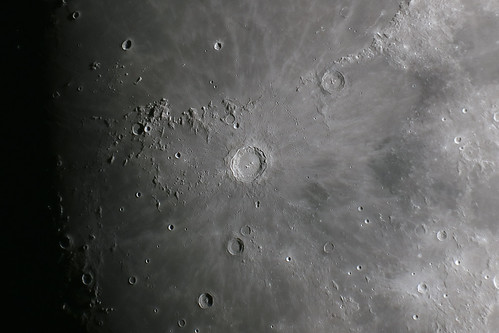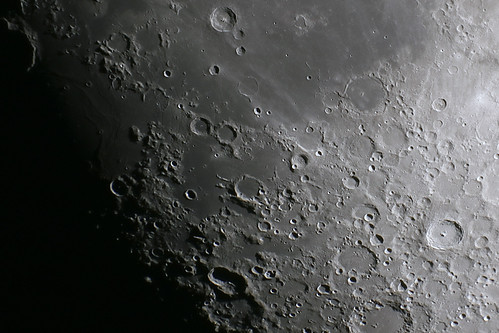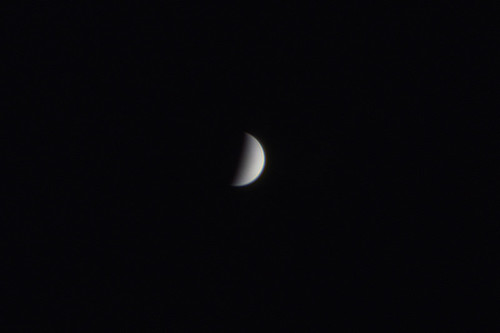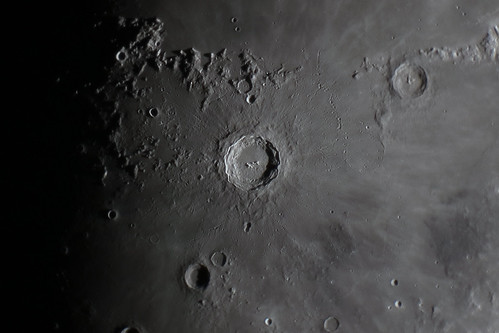Sunday, 30 May 2021
Moonshots
Tuesday, 13 April 2021
A Lunar Interlude
22 March, 18:30 – 20:00
Technically not a deep-sky post, but with the Moon just past first quarter and about as high in the sky as it can get, there's no better time to observe our nearest neighbour. Highlights included the familiar Straight Wall plus the nearby Rima Birt. Another rille was visible inside the rim of the crater Pitatus, as well as a section of the Hesiodus rille (showing a distinctly flat floor). The full extent of the Hadley rille was visible (always an indicator of good seeing) – enabling me to pinpoint the Apollo 15 landing site. Lots of fine detail in and around the Fra Mauro region. Copernicus looming on the terminator (rim illuminated, interior shadowed) with super-fine detail in the surrounding ejecta pattern. This was one of those rare occasions where I used all five Tele Vue eyepieces, although the seeing wasn’t quite good enough to warrant going above 240x with the Powermate.
I also tried Sirius again (this time in deepening twilight, after seeing a tip on Cloudy Nights), but there was still no sign of the Pup. I think the main problem I have is that when Sirius is at its highest altitude from my location, the diffraction spikes from the secondary mirror are always going to obstruct the view of Sirius B.
Nature note:
The dunnock was singing sporadically again, but the most notable observation of the evening was the sheer number of birds seen silhouetted against the moon: waves and waves of them, mostly flying east – and at a very high altitude. The sky was still somewhat blue when I first noticed them through the eyepiece, but they were invisible to the naked eye. It was very difficult to tell exactly what they were, but I would guess they were winter thrushes (fieldfares, redwings) returning to their breeding grounds.
23 March, 19:00 – 20:00
The seeing was even better tonight (although it tailed off steadily once the Moon crossed the meridian). Observations carried out at 171x (DeLite 7mm), 333x (Nagler 9mm + 2.5x Powermate) and 428x (DeLite 7mm + 2.5x Powermate).
Highlights: The three largest Plato craterlets were resolved as actual craters, as opposed to white spots. I couldn’t see the rille in Vallis Alpes, though after reading up on it later I realised I’d underestimated just how narrow it is relative to the valley. Wealth of detail in and around Copernicus – easily the best view I’ve ever had of it. Wrinkle ridges in Mare Imbrium. Cape Laplace (on the edge of Sinus Iridum) casting a very long shadow.
Moving south to Mare Nubium: The rest of the Hesiodus rille was now visible. The concentric crater structure of Hesiodus A was showing very well. Dome visible in Capuanus crater. Ramsden rilles showing really well (reminiscent of the Triesnecker complex). Hippalus rilles (from Mare Humorum) near the terminator.
Also worthy of mention: A very bright ISS pass at 19:30, moving high over the Moon and almost touching Pollux in Gemini. While this was going on I also noticed an extremely bright flare in the east from another object which looked to be travelling on a similar orbit to the ISS, roughly 90 degrees ahead of it. I haven’t yet been able to determine what it was. Stellarium plots several satellites passing through that area around that time (including a few of the ubiquitous Starlinks), but none of them appear to be related to the ISS.
Nature note:
Still a few birds flying across the face of the Moon, but not nearly as many as the previous evening.
Saturday, 26 December 2020
Mars and the Moon
28 November 2020, 19:00 – 20:00
Conditions: Quite cold (as you’d expect for the time of the year). Light film of condensation on the telescope.
Seeing: Good / excellent
Transparency: N/A
My run of good luck with the weather had to come to an end eventually, and so it proved with the months of October and November being pretty much a wash-out as far as deep-sky observing was concerned. The few windows of clear sky I did get were devoted to observing and imaging Mars, and fortunately I able to get just enough data to assemble a crude albedo map.
Tonight however was all about observing, with the seeing remaining unusually steady for once.
Mars: Good views at all magnifications from 171x up to 428x. Gibbous phase starting to become more obvious now. SPC tiny, but still bright. The albedo features were of much lower contrast than previous viewings, even with the Baader CB filter in place; but I was looking at the Tharsis / Solis Lacus region – the site of a recent major dust storm. There was a large – and prominent – bright yellowish haze near the limb (over Argyre?), plus a less obvious fainter haze further north.
The Moon: Nearly full, very bright. Viewed at 171x and 428x (with the Baader ND filter). As usual, the amount of detail on view was almost overwhelming, particularly at the higher magnification, but a few observations worthy of mention include:
At least three Plato craterlets “twinkling” in and out of view when the seeing allowed.
Mons Rümker region near the terminator, just a few days before the Chang’e 5 mission landed to collect samples.
Rimae Sirsalis showing particularly well (at 428x it looked more like a canyon than a rille).
Mare Humboldtianum visible close to the northern limb (the best view I’ve had of this elusive libration feature).
Nature note:
Tonight's soundtrack: The gentle “tseep” of winter thrushes passing overhead, and the not so gentle clattering of a fox jumping over the fence into the garden. Its eyes lit up when I shone the torch at it, but it didn’t leave until I cleared my throat.
Wednesday, 6 May 2020
Venus and the Moon
31 March 2020 and 4 April 2020
Okay, so not a post on deep-sky observing, but still worthy of mention because Venus was high enough and bright enough to be viewable from my back garden (as it is every eight years). To get the best view I had to locate it against a blue sky - which can be tricky if the moon isn't nearby. It was a very pretty sight at 171x, with none of the halo or colour distortion that I often got with the SP-102. On 31 March the phase was similar to that of the moon, but there was no detail in the cloud tops (not that I was expecting to see any.)
I didn’t photograph the Venus/Pleiades conjunction (a fast 300mm lens or one of those RedCat scopes would be better suited for that), but I did get a nice view of it through binoculars over several consecutive evenings.
I also got to study the moon with the 7mm DeLite and it was every bit as good as I’d expected: crisp, contrasty, and a good complement to my other magnifications. On 31 March I had my best ever view of the Triesnecker rille system, with the detail visible through the eyepiece exceeding the stacked image for once.
On 4 April the seeing was good enough for me use the 2.5x Powermate, pushing the magnification up to a whopping 428x. I previously wrote that the DeLite doesn’t have the “wow” factor of the Ethos, but this was definitely a “wow” moment of a very different kind; I’ve never seen the moon quite like that before. The detail visible in Gassendi alone was almost too much to take in. The seeing is consistently better in late summer / early autumn (in my neck of the woods at least), which bodes well for the upcoming Mars apparition.
(Back to galaxies in the next post!)
Tuesday, 13 August 2019
Lunar Detour
14 February 2019, 18:45 – 20:15
A chilly evening after an unseasonably mild day – resulting in the heaviest condensation I've experienced to date, particularly on the secondary mirror. Fortunately, there was only one target tonight - a high, bright gibbous moon.
Seeing was variable with occasional moments of exceptional clarity (a finding backed up by the imaging tests). The moon was dazzlingly bright even at 240x (5mm Nagler) – at least until the condensation set in.
Visually, I saw 3 craterlets in Plato, the centre one clearly resolved.
Rima Birt (adjacent to the Straight Wall) showed up very well despite being some distance from the terminator. (I imaged this with the SP-102, but I don’t think I was ever quite able to see it through the eyepiece.)
Rima Hesiodus was long and very distinctive.
At least one rille was visible inside the rim of Pitatus.
Copernicus of course was the highlight, showing far too much detail to describe here, but the image below gives an idea of what was visible (the eyepiece view occasionally exceeded this).





